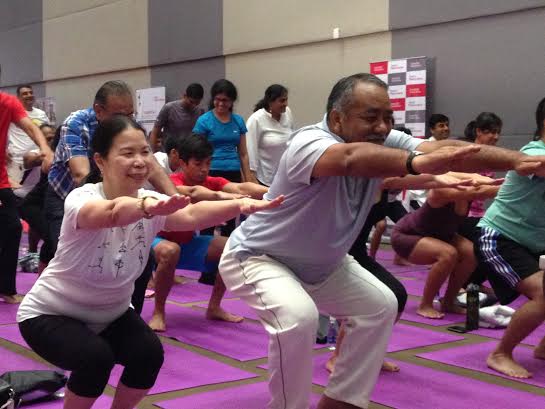
My fellow teachers and I at the Iyengar Yoga Center Manila joked that, had this been any other sector’s event, we wouldn’t be on the road at the ungodly hour of 5:30 a.m, headed for SMX at SM Aura in Taguig, carting stuff for our booth.
Then again, this was a gathering of yoga practitioners, getting together for a milestone event—the very first celebration in the Philippines of the International Day of Yoga last June 21.
Considering that yoga as a philosophy has been around for some 5,000 years, this has certainly been a long time coming. Formerly the province of hippies and New Age groupies, the Indian belief system has spread all over the world and hit the mainstream as a healthful practice, a way to a tranquil mind, a good “workout” (although serious practitioners would probably cringe at the word) and—more cringing ahead—a billion-dollar industry involving exclusive retreats, designer apparel and its share of controversy.
Still, the official recognition was welcome, and Indian Prime Minister Shri Narendra Modi won much acclaim for pushing for this recognition last September 2014 at the 69th Session of the United Nations General Assembly (UNGA), tying the practice up with current grim realities.
Oneness
“Yoga is not about exercise, but to discover the sense of oneness with ourselves, the world and nature,” he said. “By changing our lifestyle and creating consciousness, it can help us to deal with climate change. Let us work towards adopting an International Yoga Day.”
The UNGA approved the proposal in December, and Modi walked the talk by leading thousands of his countrymen in doing asana (postures) on the day itself. After all, India has its own Ministry of Ayurveda, Yoga and Naturopathy, Unani, Siddha and Homeopathy (AYUSH) supervising their ancient healing arts.
In Manila, the Indian Embassy, led by His Excellency Ambassador Lalduhthlana Ralte, teamed up with the Asia Society, digital company Tech Mahindra, and local groups Brahma Kumaris, Art of Living Foundation, Urban Ashram and the Iyengar Yoga Center Manila. By 7 a.m., the floor of SMX Aura was covered with yoga mats, and practitioners in all sorts of attire had taken their places on the floor.
Ambassador Ralte welcomed guests by explaining the traditional yogic greeting of “Namaste,” roughly translated as “the divine in me recognizes the divine in you.” “The world is moving to isolation, with children playing on their cellphones, and fewer of them playing in parks,” he said. “In India, we believe the world is one, and yoga is a connector. Practice will bring us together… Plus, it is sustainable, natural and takes up less of the world’s resources.”
Praveen Agrawal, country director of the UN World Food Programme, read the message of UN Secretary General Ban Ki-moon, who lauded the “wholistic benefits of this timeless practice,” and noted, quite fittingly, that “yoga does not discriminate” according to race, age, nationality, and even state of health.
Asia Society Philippines Foundation Inc. Suyin Liu Lee also gave some welcome remarks.
Iyengar Yoga Center Manila founder and director Rina Ortiz, a student of the late yoga master B.K.S. Iyengar, talked about how the practice was a good fit with Filipinos. “After all, there is much that is shared by our two cultures,” Ortiz said. “Indians and Filipinos are hardworking people, devoted to our families, lovers of life and nature, warm and open and concerned for our fellow human beings. Most significantly, we are deeply spiritual people, believers in a higher power that graces our existence.”
Good human being
Ortiz emphasized how yoga goes beyond the realm of the physical. “There’s a very big clue in Patanjali’s definition of yoga itself—yoga cittavrtti nirodhah. Yoga is the cessation of the fluctuations of the mind… For even as we gain control over our body, there is a whole dimension of the inner self—and our self in relation to the universe—that remains to be explored… It’s about being a good practitioner, which also means being a good human being.”
People got the chance to move with a demonstration led by some practitioners, including yoga teacher Tessa Celdran, and engagingly annotated by Speedo Philippines president and long-time practitioner Chandru Mahtani.
The sequence was based on a pamphlet on “Common Yoga Protocol” distributed at the event, released by the Government of India and AYUSH, with some basic and general principles for anyone wanting to get into the practice. The asana ranged from simple neck bending, to Celdran’s much applauded headstand. It was great to see Ambassador Ralte up front and center, in sweatpants and T-shirt, gamely doing the poses.
As if to remind everyone of the practice’s more spiritual dimension, Rajni Daulatram, Brahma Kumaris coordinator for Japan and the Philippines, led a guided meditation that encouraged people to reconnect with their basic nature as souls and beings of peace.
Then, it was asana time again, as Nica Hechanova of Urban Ashram led the group in more lively poses. A sweet reminder that June 21 was Father’s Day was the sight of three-year-old Jyoti Lakshmi hanging on to her father, Udaya Narayana, while he did the poses. Hechanova also gathered some children for a 10-minute children’s sequence, proof that yoga is indeed for all ages.
Finally, Amit Sharma of the Art of Living Foundation gave a talk on the workings of the mind, and led the group in another meditation that involved vigorous breathing as well as relaxation.
It was a productive and well-attended half-day event, and practitioners hoped it was only the first of many more annual celebrations to come.